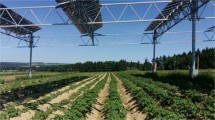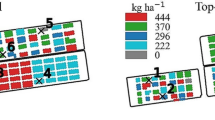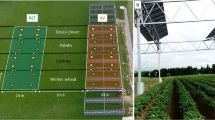Abstract
In order to improve photosynthesis efficiency and crop growth, it is important to predict CO2 concentration as well as CO2 consumption in greenhouses. The objective of this study was to predict greenhouse CO2 concentration via an artificial neural network (ANN) that incorporated environmental factors. Temperature, relative humidity, atmospheric pressure, solar radiation, and CO2 concentration were measured every 10 min over a 6-month period in a greenhouse located in Boryeong, Korea. Measured environmental data were used to train the ANN. Among the 14,866 data points used in the experiment, 10,000 and 4866 data points were used for training and testing, respectively. An ANN with an input layer with input neurons, two hidden layers with 32–2048 neurons, and an output later with one neuron was selected. A rectified linear unit was used as the activation function in each node of the ANN. An ANN structure that included 256 neurons in the hidden layers showed the highest test accuracy (R2 = 0.97) was selected from all the structures, while multivariate linear regression showed lower test accuracy than the ANN (R2 = 0.78). The ANN accurately estimated CO2 concentration in the greenhouse using big data for changing patterns of the inside environmental factors without vent position data. Furthermore, it is possible to estimate crop CO2 consumption in greenhouses with this ANN using the change in greenhouse CO2 concentration.






Similar content being viewed by others
References
Beltramo T, Ranzan C, Hinrichs J, Hitzmann B (2016) Artificial neural network prediction of the biogas flow rate optimised with an ant colony algorithm. Biosyst Eng 143:68–78
Cha MK, Jeon YA, Son JE, Chung SO, Cho YY (2016) Development of a greenhouse environment monitoring system using low-cost microcontroller and open-source software. Korean J Hort Sci Technol 34:860–870
Critten DL (1991) Optimization of CO2 concentration in greenhouses: a modelling analysis for the lettuce crop. J Plant Biochem Biotechnol 48:261–271
Cuce E, Harjunowibowo D, Cuce PM (2016) Renewable and sustainable energy saving strategies for greenhouse systems: a comprehensive review. Renew Sust Energ Rev 64:34–59
Ehret D, Lau A, Bittman S, Lin W, Shelford T (2001) Automated monitoring of greenhouse crops. Agronomie 21:403–414
Fernandez JE, Bailey BJ (1992) Measurement and prediction of greenhouse ventilation rates. Agric Forest Meteorol 58:229–245
Guo SR, Sun J, Shu S, Lu XM, Tian J, Wang JW (2012) Analysis of general situation, characteristics, existing problems and development trend of protected horticulture in China. China Veg 18:1–14
Kingma D, Ba J (2014) Adam: a method for stochastic optimization. arXiv preprint arXiv:1412.6980v9
LeCun Y, Bengio Y, Hinton G (2015) Deep learning. Nature 521:436–444
Linker R, Seginer I, Gutman PO (1998) Optimal CO2 control in a greenhouse modeled with neural networks. Comput Electron Agric 19:289–310
Lopez G, Rubio MA, Martınez M, Batlles FJ (2001) Estimation of hourly global photosynthetically active radiation using artificial neural network models. Agric Forest Meteorol 107:279–291
McMurtrie RE, Wang YP (1993) Mathematical models of the photosynthetic response of tree stands to rising CO2 concentrations and temperatures. Plant Cell Environ 16:1–13
Min J, Zhang H, Shi W (2012) Optimizing nitrogen input to reduce nitrate leaching loss in greenhouse vegetable production. Agric Water Manag 111:53–59
Sonneveld C, Van den Bos AL, Voogt W (2005) Modeling osmotic salinity effects on yield characteristics of substrate-grown greenhouse crops. J Plant Nutr 27:1931–1951
Tetko IV, Livingstone DJ, Luik AI (1995) Neural network studies. 1. Comparison of overfitting and overtraining. J Chem Inf Comput Sci 35:826–833
Trejo-Perea M, Herrera-Ruiz G, Rios-Moreno J, Miranda RC, Rivasaraiza E (2009) Greenhouse energy consumption prediction using neural networks models. Int J Agric Biol 11:1–6
Vaidyanathan S (2015) 3-Cells cellular neural network (CNN) attractor and its adaptive biological control. Int J PharmTech Res 8:632–640
Wang T, Gao H, Qiu J (2016) A combined adaptive neural network and nonlinear model predictive control for multirate networked industrial process control. IEEE Trans Neural Netw Learn Syst 27:416–425
Yu H, Chen Y, Hassan SG, Li D (2016) Prediction of the temperature in a Chinese solar greenhouse based on LSSVM optimized by improved PSO. Comput Electron Agric 122:94–102
Acknowledgements
This research was supported by the Project of ‘Development of Different Industry-Combined Smart System Test Bed for the Utilization of Power Plant-Hot Waste Water and CO2′ (20142020103570), Ministry of Trade, Industry and Energy, the Republic of Korea.
Author information
Authors and Affiliations
Corresponding author
Rights and permissions
About this article
Cite this article
Moon, T.W., Jung, D.H., Chang, S.H. et al. Estimation of greenhouse CO2 concentration via an artificial neural network that uses environmental factors. Hortic. Environ. Biotechnol. 59, 45–50 (2018). https://doi.org/10.1007/s13580-018-0015-1
Received:
Revised:
Accepted:
Published:
Issue Date:
DOI: https://doi.org/10.1007/s13580-018-0015-1




